Numerical Prediction of Local Instability in Double Corrugated Profiles
Abstract
1. Introduction
2. Methods
2.1. The Numerical Model’s Validation
2.1.1. Experimental Data
2.1.2. Numerical Data
2.1.3. Hierarchical Assessment
2.2. Reference Numerical Model and Analysis Criteria
- (a)
- Stage 1: geometry of the initial state of the phase I (pre-buckling elastic range). Stress below the yield strength.
- (b)
- Stage 2: geometry of the phase II state (pre-buckling elasto-plastic range) at a load corresponding to the load-carrying capacity (critical point). This stage has two ranges, IIa (linear) and IIb, with the presence of strong nonlinearities. In range II, plastic buckling was formed, and there was an onset of a rapid deformation increase. The determination of the stresses initiating plastic buckling formation is illustrated in Figure 11.
- (c)
- Stage 3: geometry of phase III state (post-buckling elastoplastic range) with the load in the plastic phase corresponding to the load-bearing capacity (ultimate point) when the ultimate strength is obtained. After exceeding phase III, the test element rapidly enters the fail state IV.
3. Results
Test Results
- stage I, time: 2.0 (linear range);
- stage IIa, time: 5.4 (pre-buckling linear elastoplastic range);
- stage IIb, time: 7.4 (pre-buckling nonlinear elastoplastic range);
- stage III, time: 7.95 (post-buckling elastoplastic range).
4. Discussion
5. Conclusions
Author Contributions
Funding
Institutional Review Board Statement
Informed Consent Statement
Data Availability Statement
Conflicts of Interest
References
- Decker, J.; Chiei, C. Quonset Hut; Decker, J., Chiei, C., Eds.; Princeton Archit Press: New York, NY, USA, 2005. [Google Scholar]
- Garnetr, J.S. World War II Temporary Military Buildings: A Brief History of the Architecture and Planning of Cantonments and Training Stations in the United States; Port Royal Road Springfield: Springfield, MO, USA, 1993. [Google Scholar]
- Piekarczuk, A. Experimental and Computational Evaluation Methods of Arch-Shaped Roof Made of Double Corrugated Shells; Instytut Techniki Budowlanej: Warsaw, Poland, 2018. (In Polish) [Google Scholar]
- Roye, K. Metal Building Construction Using the MIC-240 ABM K-Span Machine; Naval Postgraduate School: Monterey, CA, USA, 1996. [Google Scholar]
- Biegus, A. Trapezoidal sheet as a bracing preventing flat trusses from out-of-plane buckling. Arch. Civ. Mech. Eng. 2015, 15, 735–741. [Google Scholar] [CrossRef]
- European Committee for Standardisation EN 1993-1-3. Eurocode 3: Design of Steel Structures—Part 1–3: General Rules—Supplementary Rules for Cold-Formed Members and Sheeting; European Committee for Standardisation: Brussels, Belgium, 2006. [Google Scholar]
- European Committee for Standardisation EN 1993-1-5. Eurocode 3: Design of Steel Structures—Part 1–5: General Rules—Plated Structural Elements; European Committee for Standardisation: Brussels, Belgium, 2006. [Google Scholar]
- European Committee for Standardisation EN 1993-1-6. Eurocode 3: Design of Steel Structures—Part 1–6: Strength and Stability of Shell Structures; European Committee for Standardisation: Brussels, Belgium, 2007. [Google Scholar]
- Biegus, A.; Kowal, A. Collapse of halls made from cold-formed steel sheets. Eng. Fail. Anal. 2013, 31, 189–194. [Google Scholar] [CrossRef]
- Rindos, P.V. Starej Ľubovni Sa Zrútila Strecha Zimného Štadióna. Available online: https://spis.korzar.sme.sk/c/6696874/v-starej-lubovni-sa-zrutila-strecha-zimneho-stadiona.html (accessed on 8 December 2017).
- Pustayová, J. Spadnutá Strecha Štadióna: Príčina Je Už Známa. Available online: http://www.pluska.sk/regiony/stredne-slovensko/spadnuta-strecha-stadiona-pricina-je-znama.html (accessed on 8 December 2017).
- Aнacтacия Зaгyмeнcкaя. Pyкoвoдcтвo Пapкa Южнo-Сaxaлинcкa Ищeт Пpичины Обpyшeния Кpыши Aнгapa. Available online: https://skr.su/news/post/105972/ (accessed on 24 November 2020).
- Alamy Limited. Available online: https://www.alamy.com/stock-photo/k-span.html (accessed on 8 February 2021).
- Piekarczuk, A.; Więch, P.; Kuczyński, K.; Walentyński, R. Experimental and computational approaches to the evaluation of double corrugated arch structures. A review of the latest advancements. Arch. Civ. Eng. 2021, 67, 7–35. [Google Scholar] [CrossRef]
- Walentynski, R.; Cybulski, R.; Sanchez, R. Numerical stability analyses and preliminary experimental investigation of doubly corrugated steel arch panels. J. Int. Assoc. Shell Spat. Struct. 2013, 54, 3–14. [Google Scholar]
- Walentyński, R.; Cybulski, R.; Kozieł, K.J. Achilles’ heel of the ABM 120 double corrugated profiles. In Proceedings of the New Trends in Statics and Dynamics of Buildings, the Slovakia University of Technology in Bratislava, Faculty of Civil Engineering STU Bratislava Slovak Society of Mechanics SA, Bratislava, Slovakia, 20–21 October 2011; pp. 25–28. [Google Scholar]
- Walentyński, R.; Cybulski, R.; Kozieł, K. Numerical models of ABM K-Span steel arch panels. Archit. Civ. Enginnering Environ. 2011, 4, 105–114. [Google Scholar]
- Walentynski, R.; Cybulska, M.; Cybulski, R. Influence of geometric imperfections on the local stability of thin-walled elements. In Proceedings of the Shell Structures: Theory and Applications, Gdańsk, Poland, 16–18 October 2013; Volume 3, pp. 251–254. [Google Scholar]
- Cybulski, R.; Walentyński, R.; Cybulska, M. Local buckling of cold-formed elements used in arched building with geometrical imperfections. J. Constr. Steel Res. 2014, 96, 1–13. [Google Scholar] [CrossRef]
- Knyziak, P. The impact of construction quality on the safety of prefabricated multi-family dwellings. Eng. Fail. Anal. 2019, 100, 37–48. [Google Scholar] [CrossRef]
- Piekarczuk, A.; Więch, P.; Szewczak, E. Wybrane aspekty metodyki badań i obliczeń statycznych konstrukcji wsporczych sieci trakcyjnej PKP. Logistyka 2014, 6, 8596–8607. [Google Scholar]
- Kotełko, M. Load-capacity estimation and collapse analysis of thin-walled beams and columns—Recent advances. Thin-Walled Struct. 2004, 42, 153–175. [Google Scholar] [CrossRef]
- Ungureanu, V.; Kotełko, M.; Karmazyn, A.; Dubina, D. Plastic mechanisms of thin-walled cold-formed steel members in eccentric compression. Thin-Walled Struct. 2018, 128, 184–192. [Google Scholar] [CrossRef]
- Kotełko, M.; Ungureanu, V.; Dubina, D.; Macdonald, M. Plastic strength of thin-walled plated members—Alternative solutions review. Thin-Walled Struct. 2011, 49, 636–644. [Google Scholar] [CrossRef]
- Piekarczuk, A.; Więch, P.; Malowany, K. Numerical investigation into plastic hinge formation in arched corrugated thin-walled profiles. Thin-Walled Struct. 2017, 119, 13–21. [Google Scholar] [CrossRef]
- Dubina, D.; Ungureanu, V. Elastic-plastic interactive buckling of thin-walled steel compression members. In Proceedings of the International Specialty Conference on Cold-Formed Steel Structures: Recent Research and Developments in Cold-Formed Steel Design and Construction, St. Louis, MI, USA, 19–20 October 2000; pp. 223–237. [Google Scholar]
- Zhang, Y.; He, B.; Yao, L.-K.K.; Long, J. Buckling analysis of thin-walled members via semi-analytical finite strip transfer matrix method. Adv. Mech. Eng. 2016, 8, 1–11. [Google Scholar] [CrossRef]
- Shen, J.; Wadee, M.A. Sensitivity to local imperfections in inelastic thin-walled rectangular hollow section struts. Structures 2019, 17, 43–57. [Google Scholar] [CrossRef]
- Zhao, X.-L. Yield line mechanism analysis of steel members and connections. Prog. Struct. Eng. Mater. 2003, 5, 252–262. [Google Scholar] [CrossRef]
- Murray, N.W.; Khoo, P.S. Some basic plastic mechanisms in the local buckling of thin-walled steel structures. Int. J. Mech. Sci. 1981, 23, 703–713. [Google Scholar] [CrossRef]
- Piekarczuk, A. Experimental and numerical studies of double corrugated steel arch panels. Thin-Walled Struct. 2019, 140, 60–73. [Google Scholar] [CrossRef]
- Airumyan, E.; Boyko, O. Full-Scale Testing and Design of Frameless Arch Steel Roof. In Structural Assessment. The Role of Large and Full Scale Testing; Virdi, K., Raras, F., Clarke, J., Armer, G., Eds.; E & FN Spon: London, UK, 1997; pp. 211–217. ISBN 0419224904. [Google Scholar]
- Gao, X.; Haoming, Z.; Zhang, H.; Zhu, H.; Zhang, H. Research on ultimate bearing capacity of trapezium corrugated plate-assemblies arch steel roof. In Proceedings of the 2011 International Conference on Electric Technology and Civil Engineering (ICETCE), Lushan, China, 2–24 April 2011; pp. 2553–2556. [Google Scholar]
- Yagodich, M.J. Numerical Evaluation of Thin-Shelled Structural Panels. Master’s Thesis, University of Pittsburgh, Pittsburgh, PA, USA, 2003. [Google Scholar]
- Wang, X.P.; Jiang, C.R.; Li, G.Q.; Wang, S.Y. Full-scale tests and finite element analysis of arched corrugated steel roof under static loads. Steel Compos. Struct. 2007, 7, 339–354. [Google Scholar] [CrossRef]
- Piekarczuk, A.; Więch, P.; Cybulski, R. Experimental method to evaluate the load-carrying capacity of double corrugated sheet profiles. Thin-Walled Struct. 2019, 144, 106283. [Google Scholar] [CrossRef]
- Jalammanavar, K.; Pujar, N.; Vishnu Raj, R. Finite Element Study on Mesh Discretization Error Estimation for Ansys Workbench. In Proceedings of the Proceedings of the International Conference on Computational Techniques, Electronics and Mechanical Systems, CTEMS 2018, Belgaum, India, 21–22 December 2018; Institute of Electrical and Electronics Engineers Inc.: Belgaum, India, 2018; pp. 344–350. [Google Scholar]
- Nithesh, N.; Varghese, G.; Cs, S.K. Investigations on Mesh Discretization Error in Fem. Int. J. Adv. Comput. Eng. Netw. 2014, 29–34. [Google Scholar]
- Patil, H.; Jeyakarthikeyan, P.V. Mesh convergence study and estimation of discretization error of hub in clutch disc with integration of ANSYS. IOP Conf. Ser. Mater. Sci. Eng. 2018, 402, 012065. [Google Scholar] [CrossRef]
- Geirsson, H. Theory of Reference. Philosophy 2011, 3304, 724–746. [Google Scholar] [CrossRef]
- Roy, C.J.; Oberkampf, W.L. A comprehensive framework for verification, validation, and uncertainty quantification in scientific computing. Comput. Methods Appl. Mech. Eng. 2011, 200, 2131–2144. [Google Scholar] [CrossRef]
- Szewczak, E.; Piekarczuk, A. Performance evaluation of the construction products as a research challenge. Small error—big difference in assessment? Bull. Polish Acad. Sci. Tech. Sci. 2016, 64, 675–686. [Google Scholar] [CrossRef][Green Version]
- Zhao, Y.; Cao, Q.S.; Su, L. Buckling design of large circular steel silos subject to wind pressure. Thin-Walled Struct. 2013, 73, 337–349. [Google Scholar] [CrossRef]
- Walport, F.; Gardner, L.; Nethercot, D.A. Equivalent bow imperfections for use in design by second order inelastic analysis. Structures 2020, 26, 670–685. [Google Scholar] [CrossRef]
- Schneider, W.; Timmel, I.; Höhn, K. The conception of quasi-collapse-affine imperfections: A new approach to unfavourable imperfections of thin-walled shell structures. Thin-Walled Struct. 2005, 43, 1202–1224. [Google Scholar] [CrossRef]
- Kollár, D.; Kövesdi, B. Welding simulation of corrugated web girders—Part 2: Effect of manufacturing on shear buckling resistance. Thin-Walled Struct. 2019, 141, 477–488. [Google Scholar] [CrossRef]
- Beyer, A.; Boissonnade, N.; Khelil, A.; Bureau, A. Influence of assumed geometric and material imperfections on the numerically determined ultimate resistance of hot-rolled U-shaped steel members. J. Constr. Steel Res. 2018, 147, 103–115. [Google Scholar] [CrossRef]
- National Agency for Finite Element Methods and Standards. Available online: https://www.nafems.org/ (accessed on 21 June 2017).
- Roache, P.J. Verification and Validation in Computational Science and Engineering; Hermosa Publishers: Hermosa, CA, USA, 1998; ISBN 0913478083. [Google Scholar]
- Babuska, I.; Tinsley Oden, J. Verification and validation in computational engineering and science: Basic concepts. Comput. Methods Appl. Mech. Engrg 2004, 193, 4057–4066. [Google Scholar] [CrossRef]
- Oberkampf, W.L.; Trucano, T.G.; Hirsch, C. Verification, validation, and predictive capability in computational engineering and physics. Appl. Mech. Rev. 2004, 57, 345. [Google Scholar] [CrossRef]
- Roy, C.J. Review of code and solution verification procedures for computational simulation. J. Comput. Phys. 2005, 205, 131–156. [Google Scholar] [CrossRef]
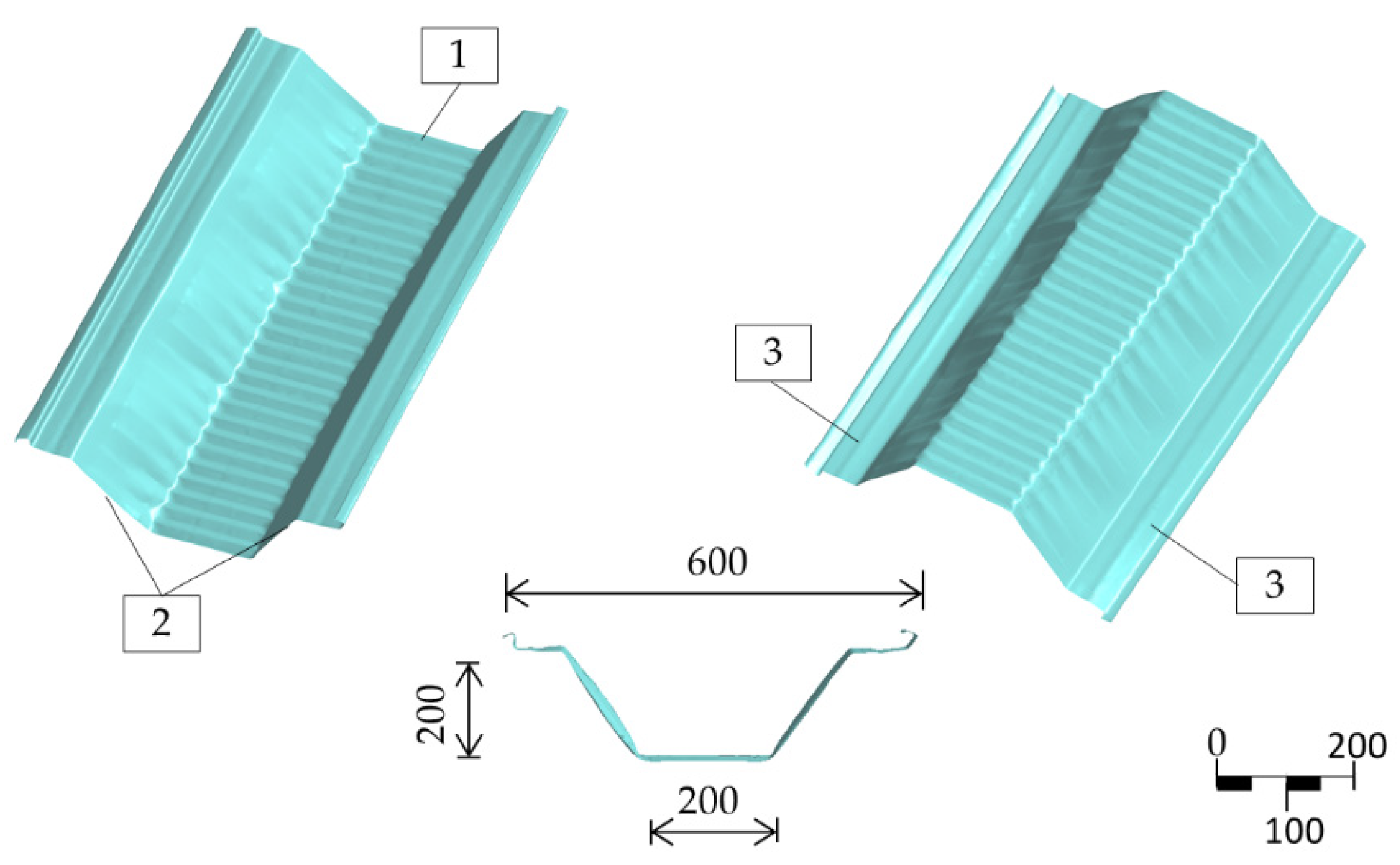

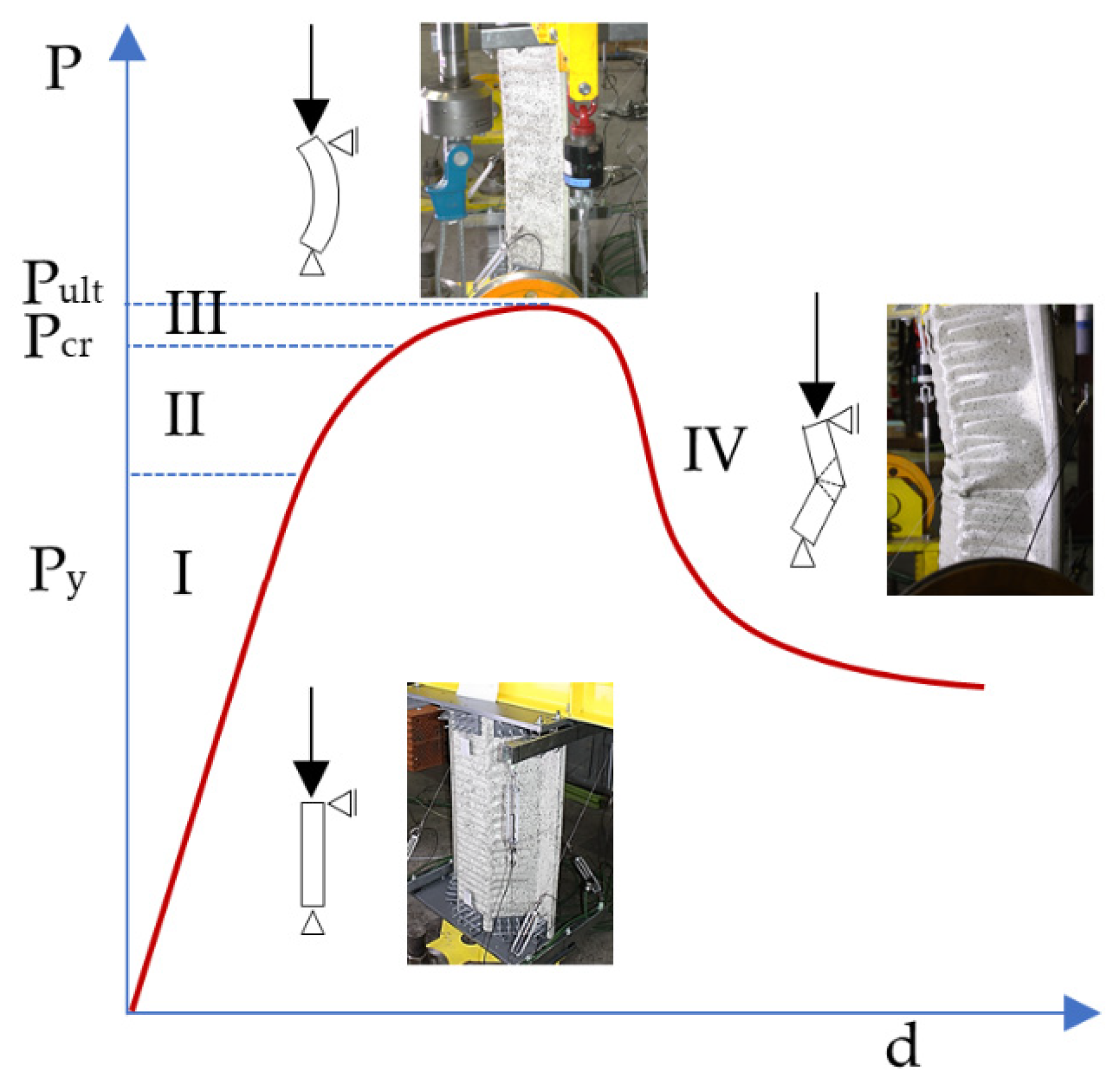
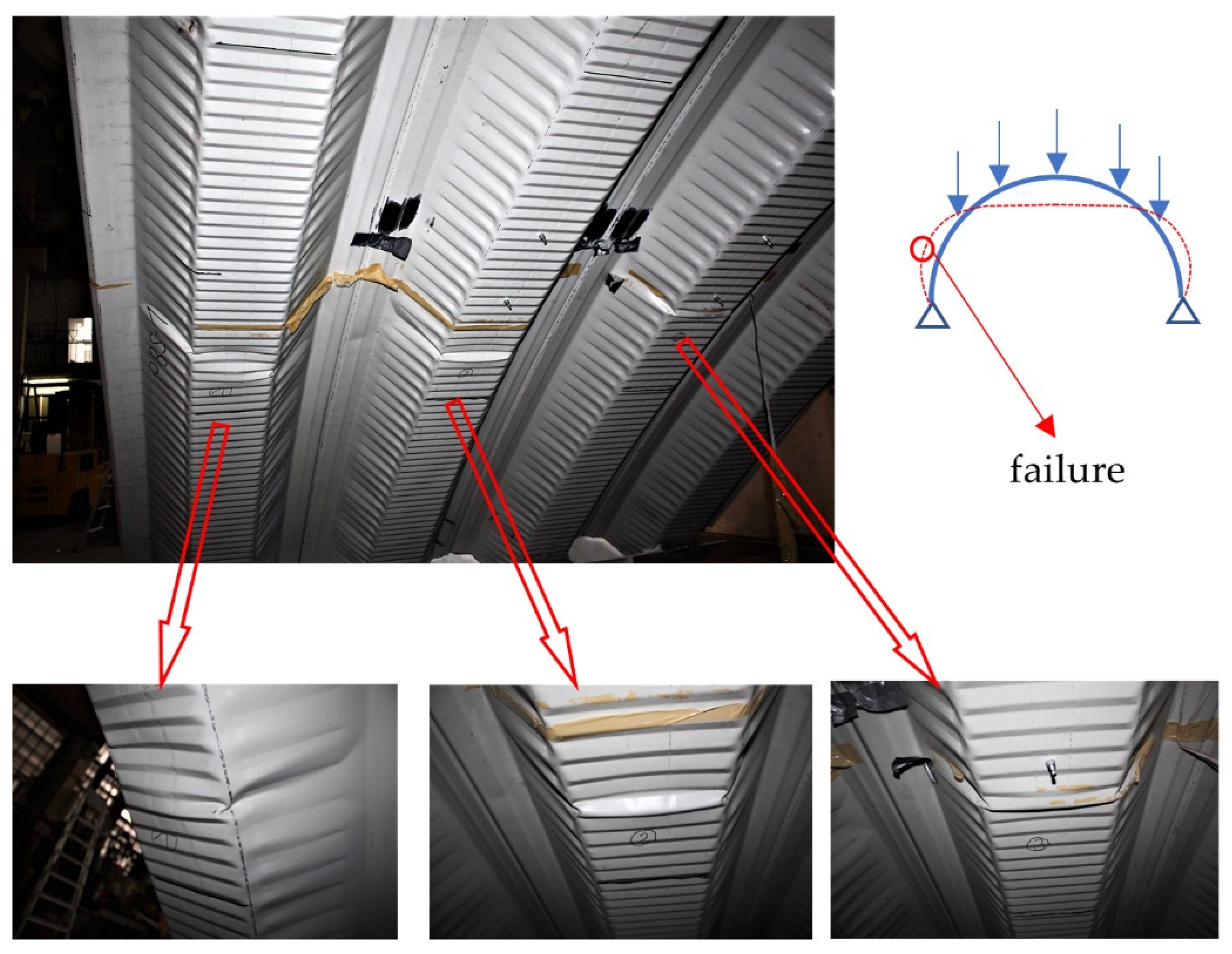
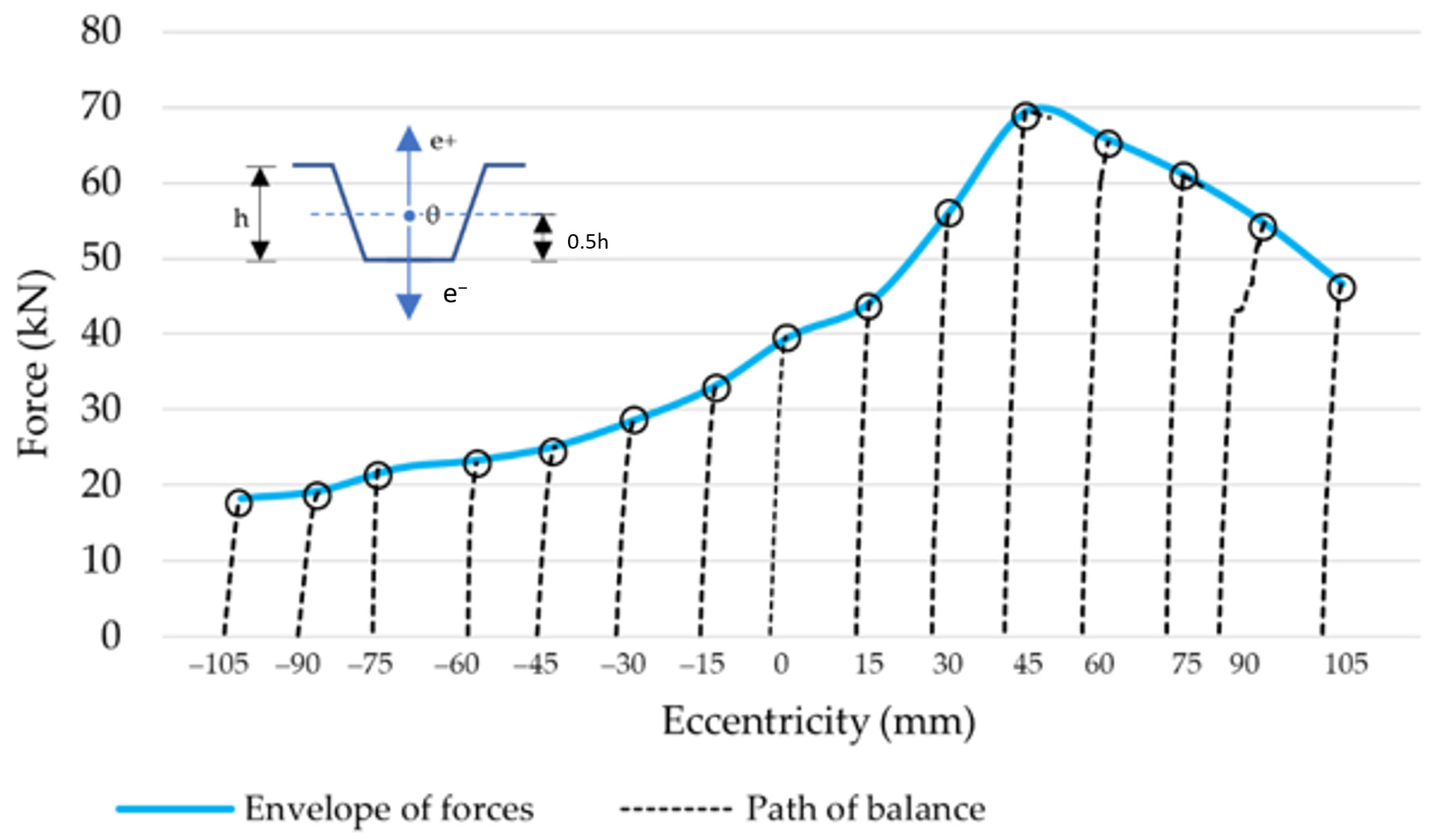


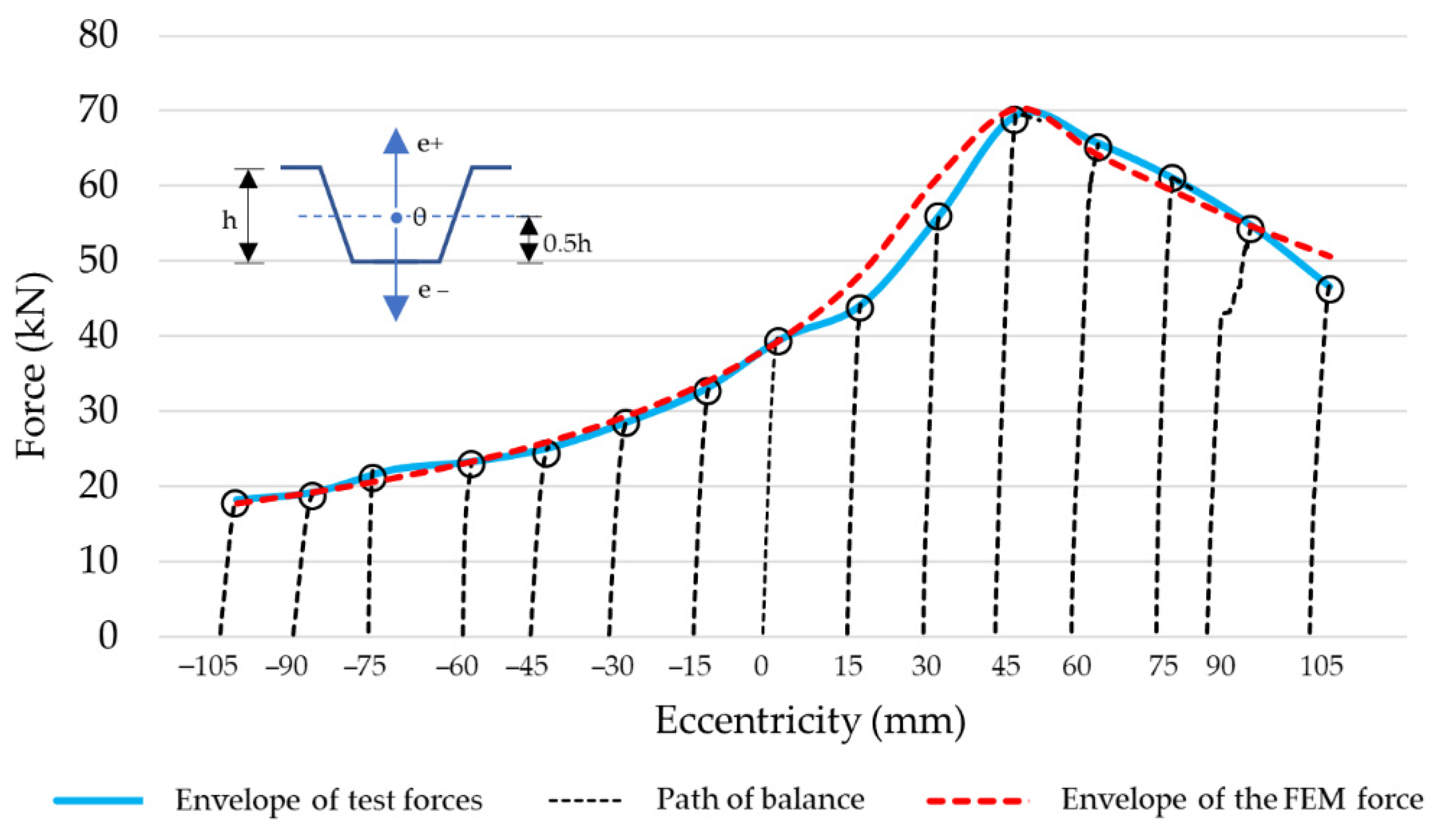

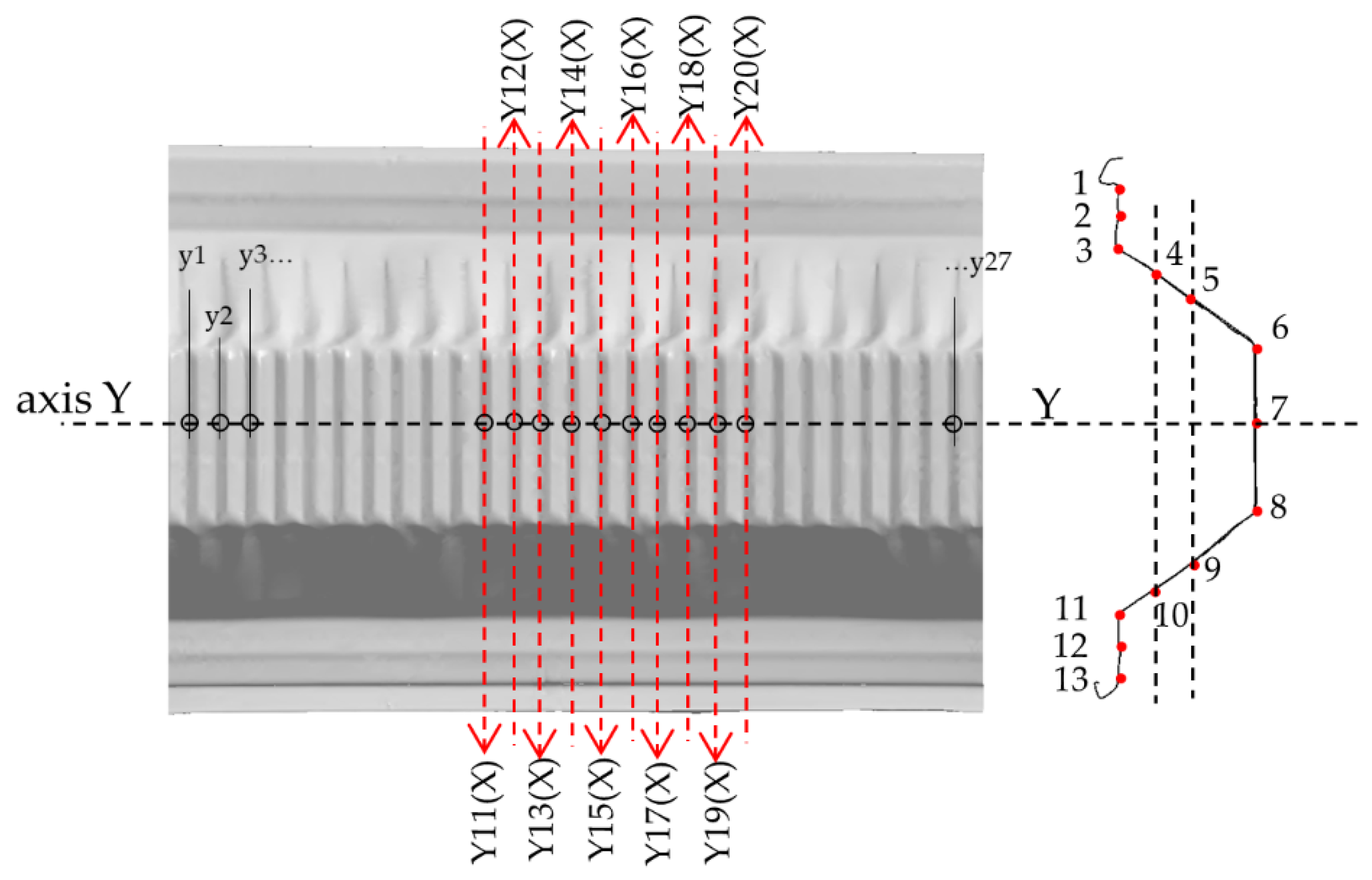
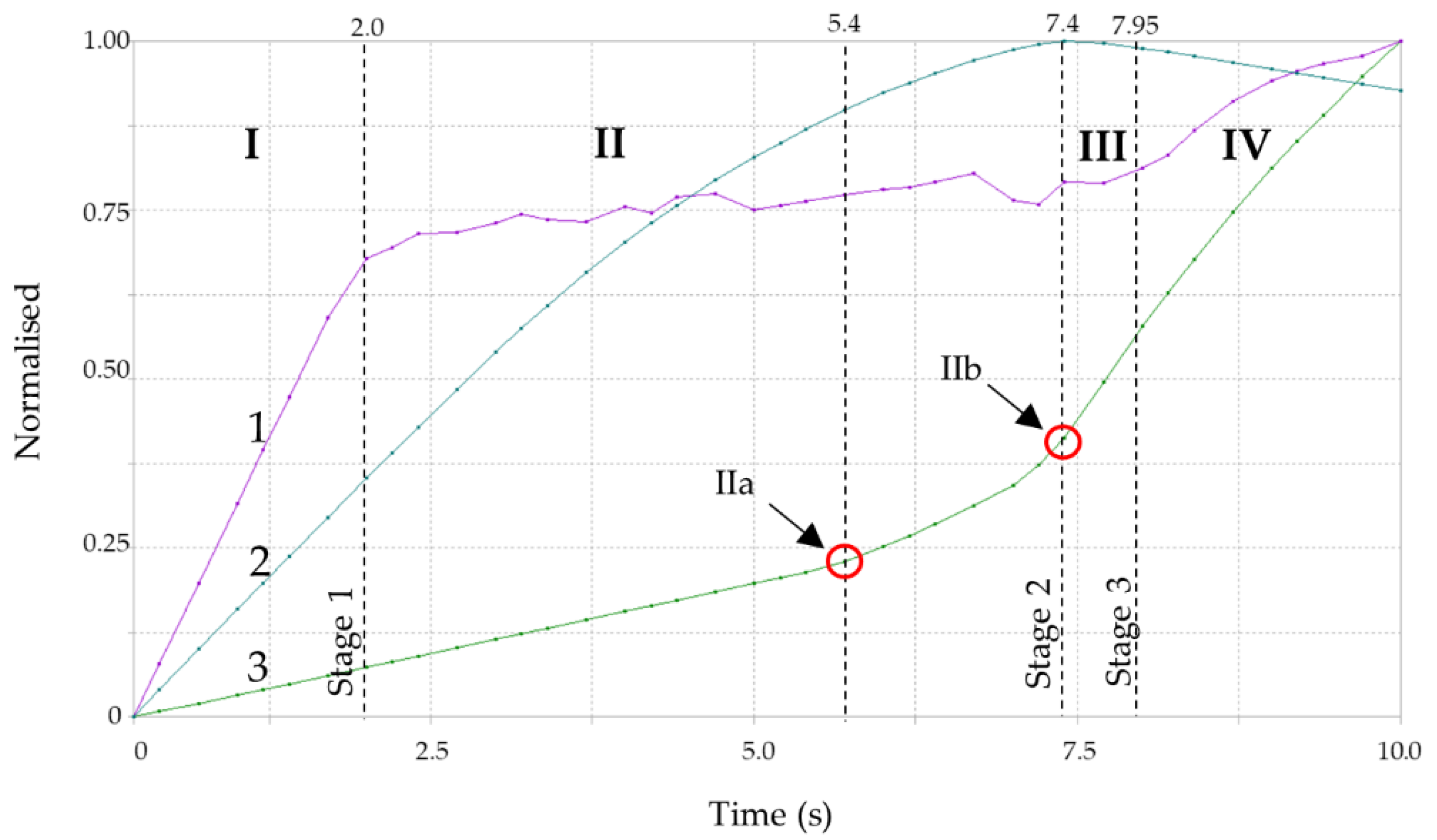


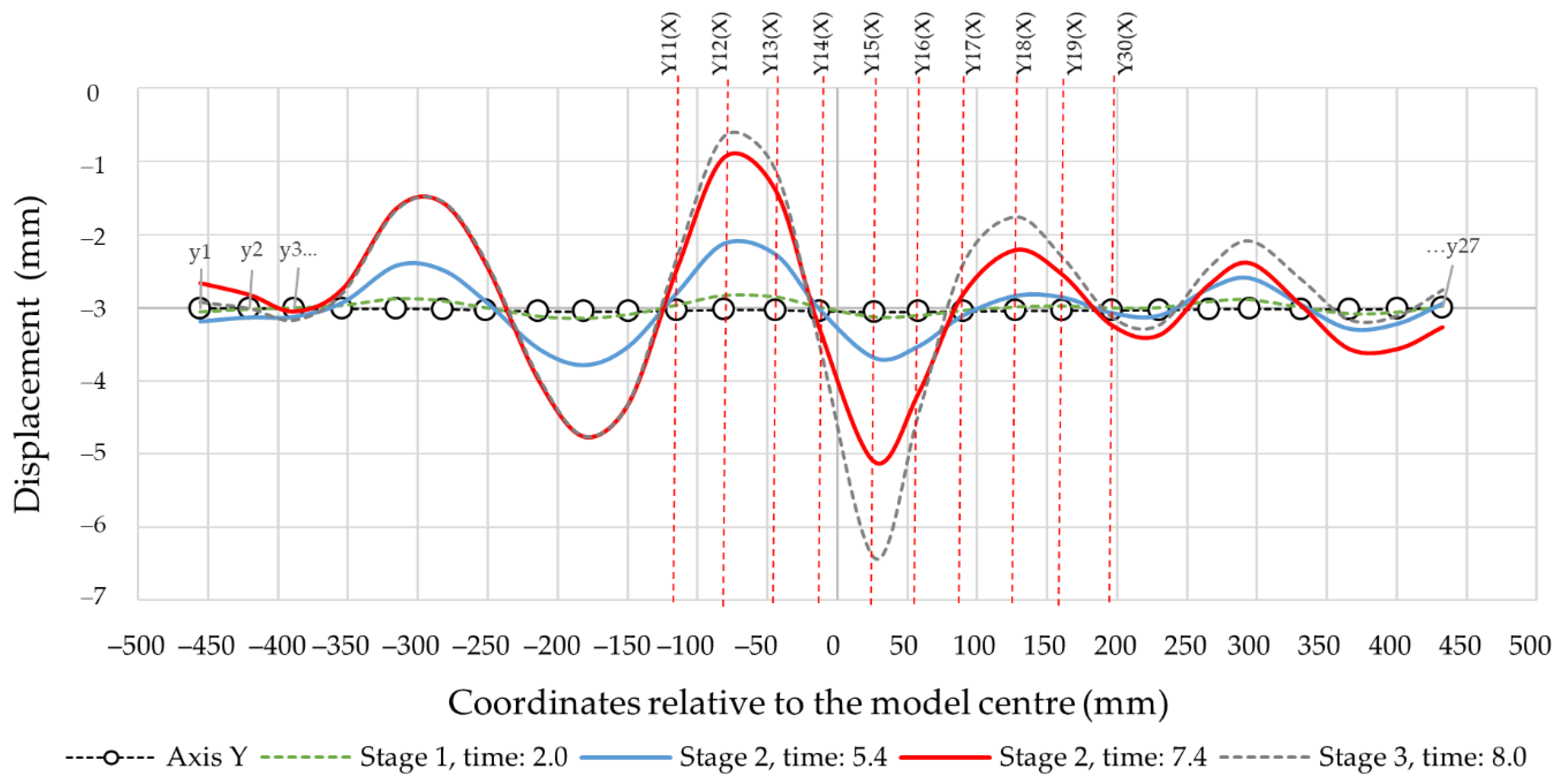
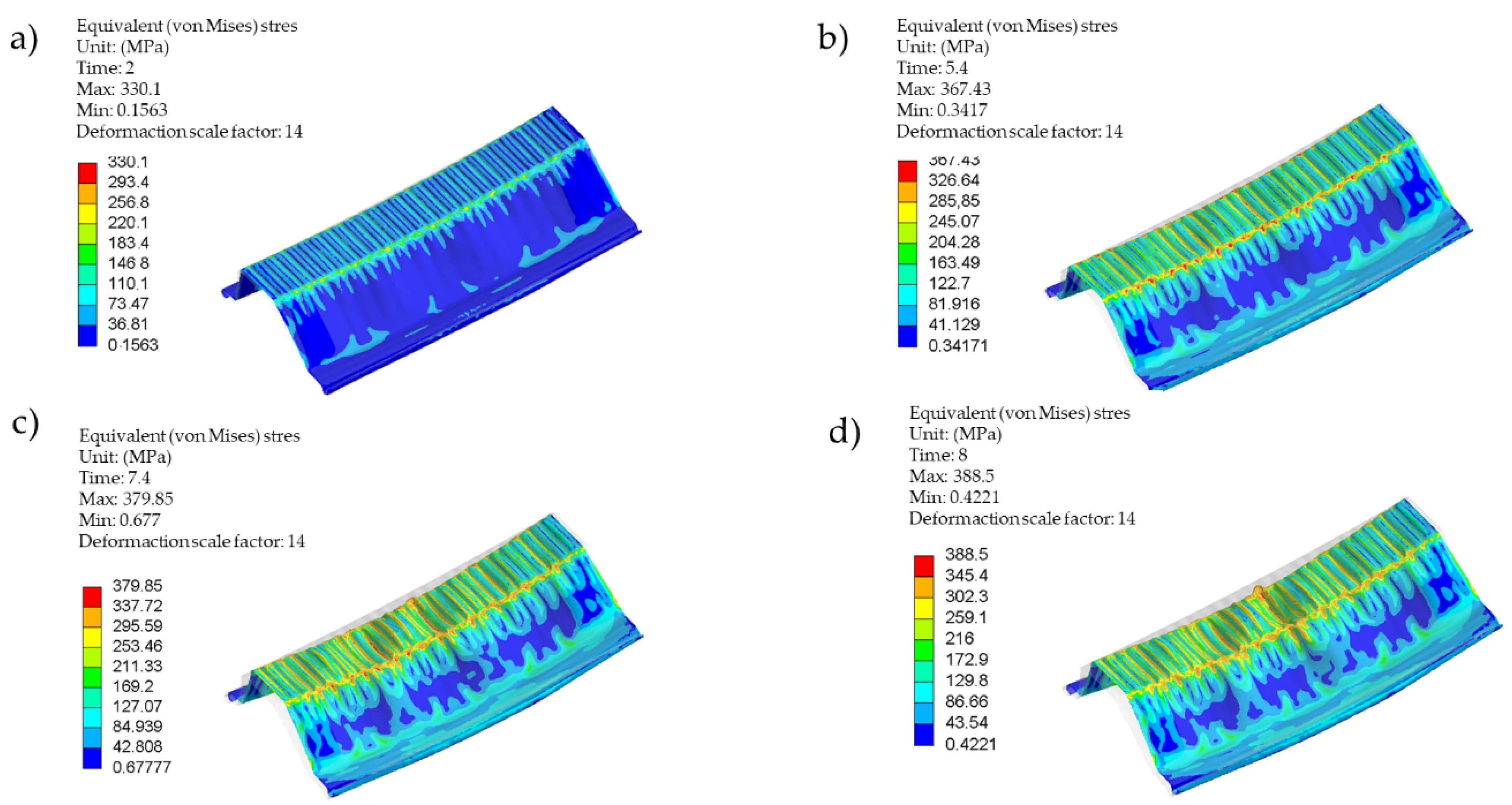

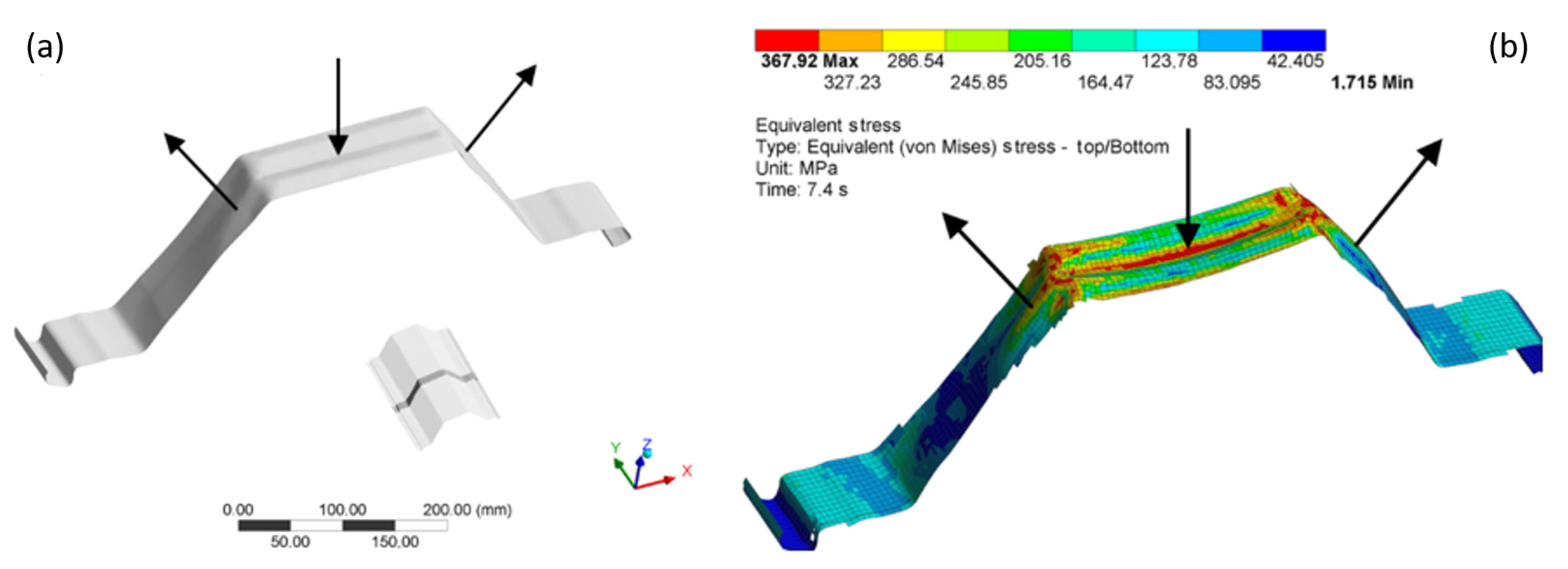
| Force, Ftest (kN) | Eccentricity, e (mm) |
|---|---|
| 18.201 | −105 |
| 19.219 | −90 |
| 22.201 | −75 |
| 23.260 | −60 |
| 25.119 | −45 |
| 28.570 | −30 |
| 32.936 | −15 |
| 39.768 | 0 |
| 44.190 | 15 |
| 56.101 | 30 |
| 69.561 | 45 |
| 65.898 | 60 |
| 61.050 | 75 |
| 54.760 | 90 |
| 46.644 | 105 |
| Force, Ftest, M0 (kN) | Displacement, d (mm) |
|---|---|
| 0 | 0.00 |
| 9.645 | 0.50 |
| 18.860 | 1.00 |
| 27.553 | 1.50 |
| 34.345 | 2.00 |
| 38.481 | 2.50 |
| 39.768 | 2.92 |
| D (mm) | FFEM (kN) | Nodes | FFEM/Ftest | δ (%) |
|---|---|---|---|---|
| 1.5 | 38.061 | 393.856 | 0.957 | 4.30 |
| 2.5 | 38.420 | 143.352 | 0.966 | 3.39 |
| 5.0 | 39.714 | 40.034 | 0.999 | 0.14 |
| 7.5 | 40.733 | 22.852 | 1.024 | 2.42 |
| 10 | 41.035 | 18.640 | 1.032 | 3.18 |
| 12.5 | 41.141 | 17.442 | 1.035 | 3.45 |
| 15.0 | 41.273 | 17.002 | 1.038 | 3.78 |
| 17.5 | 41.352 | 16.827 | 1.040 | 3.98 |
| 20.0 | 41.337 | 16.786 | 1.039 | 3.94 |
| Eccentricity, e (mm) | Ftest (kN) | FFEM (kN) | δe (%) |
|---|---|---|---|
| −105 | 18.201 | 17.698 | 2.77% |
| −90 | 19.219 | 19.228 | 0.05% |
| −75 | 22.201 | 21.043 | 5.22% |
| −60 | 23.260 | 23.241 | 0.08% |
| −45 | 25.119 | 25.944 | 3.29% |
| −30 | 28.570 | 29.355 | 2.75% |
| −15 | 32.936 | 33.797 | 2.62% |
| 0 | 39.768 | 39.764 | 0.01% |
| 15 | 44.190 | 48.342 | 9.40% |
| 30 | 56.100 | 61.388 | 9.43% |
| 45 | 69.561 | 70.247 | 0.99% |
| 60 | 65.898 | 64.236 | 2.52% |
| 75 | 61.050 | 59.217 | 3.00% |
| 90 | 54.760 | 54.563 | 0.36% |
| 105 | 46.644 | 50.566 | 8.41% |
| Displacement, d (mm) | Ftest (kN) | FFEM (kN) | δM0 (%) |
|---|---|---|---|
| 0 | 0 | 0 | 0 |
| 0.50 | 9.645 | 9.852 | 2.15% |
| 1.00 | 18.860 | 20.070 | 6.42% |
| 1.50 | 27.553 | 28.385 | 3.02% |
| 2.00 | 34.345 | 34.011 | 0.97% |
| 2.50 | 38.481 | 37.965 | 1.34% |
| 2.92 | 39.768 | 39.764 | 0.01% |
| Stage | Time | FFEM (kN) | εel × 10−3 | εpl × 10−3 | σ (MPa) | σ/fy |
|---|---|---|---|---|---|---|
| I | 2.0 | 15.023 | 1.644 | 0.00 | 337.00 | 1.000 |
| IIa | 5.4 | 34.778 | 1.878 | 7.804 | 367.43 | 1.090 |
| IIb | 7.4 | 39.764 | 1.967 | 23.864 | 379.85 | 1.127 |
| III | 7.95 | 39.763 | 2.106 | 48.572 | 387.01 | 1.153 |
Publisher’s Note: MDPI stays neutral with regard to jurisdictional claims in published maps and institutional affiliations. |
© 2021 by the authors. Licensee MDPI, Basel, Switzerland. This article is an open access article distributed under the terms and conditions of the Creative Commons Attribution (CC BY) license (https://creativecommons.org/licenses/by/4.0/).
Share and Cite
Piekarczuk, A.; Więch, P. Numerical Prediction of Local Instability in Double Corrugated Profiles. Materials 2021, 14, 6002. https://doi.org/10.3390/ma14206002
Piekarczuk A, Więch P. Numerical Prediction of Local Instability in Double Corrugated Profiles. Materials. 2021; 14(20):6002. https://doi.org/10.3390/ma14206002
Chicago/Turabian StylePiekarczuk, Artur, and Przemysław Więch. 2021. "Numerical Prediction of Local Instability in Double Corrugated Profiles" Materials 14, no. 20: 6002. https://doi.org/10.3390/ma14206002
APA StylePiekarczuk, A., & Więch, P. (2021). Numerical Prediction of Local Instability in Double Corrugated Profiles. Materials, 14(20), 6002. https://doi.org/10.3390/ma14206002






